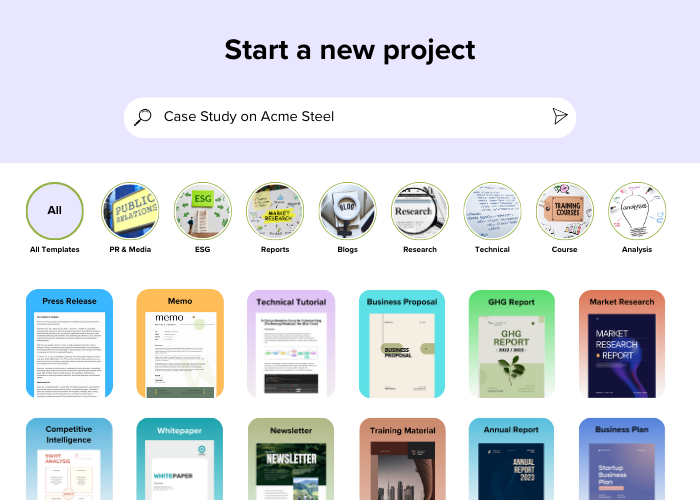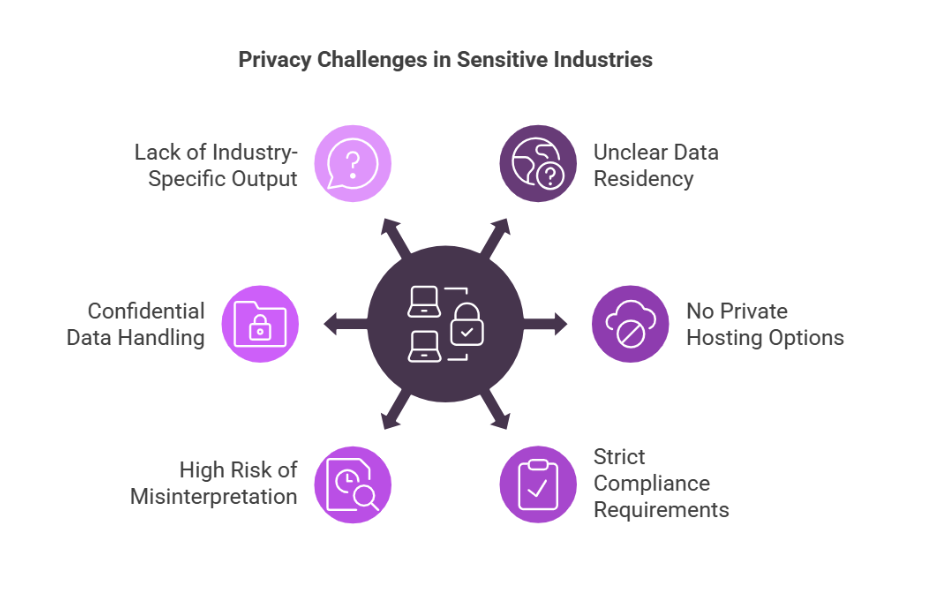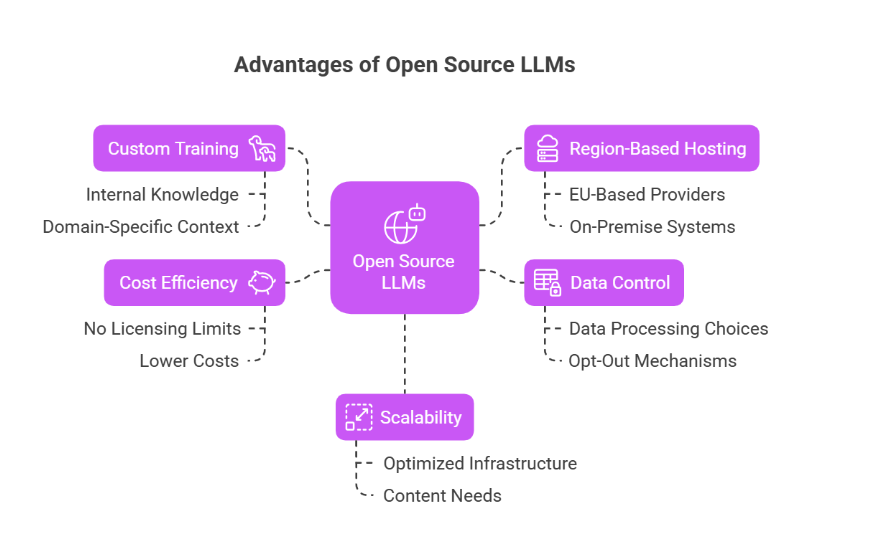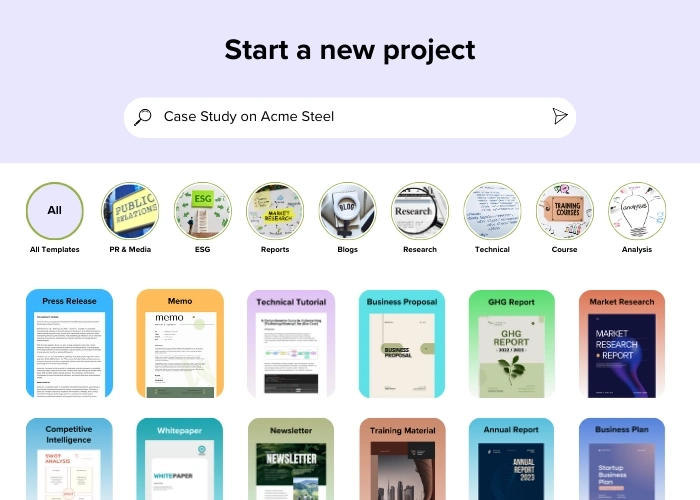How Supercraft Streamlines AI-Powered Content Workflows for Privacy-Focused Industries
This blog explains how Supercraft platform uses sovereign AI to streamline content workflows in privacy-focused industries.

This blog explains how Supercraft platform uses sovereign AI to streamline content workflows in privacy-focused industries.

More businesses are using generative AI than ever before. A recent McKinsey report says that 71% of organizations use it in at least one part of their work.
We know how fast and efficient AI can be when it comes to writing, gathering data, and even intense research-based work. But, if you are in a domain that demands sovereignty of data, like healthcare, finance, or law, platform models will not serve your purpose.
You're probably using open-source models in your workflows already or, perhaps, you have developed your own AI systems. But most tools will still ask you to switch tabs, plug into multiple services, and piece things together. Remaining private, secure, and compliant all at the same time is not always easy.
In this article, we'll discuss what makes content workflows challenging in privacy-first industries. Then, we'll look at how private infrastructure and open-source LLMs can help you. Finally, we'll demonstrate how Supercraft, our all-in-one AI tool, gives exactly what you need!
If you work in healthcare, finance, or legal you need to protect sensitive data and stay compliant at every step of the process. Here are the key challenges you may come across:
Unclear Data Residency: You may not always know where your content is stored or how it moves between systems.
No Private Hosting Options: Most tools don't support encrypted workflows or allow you to host models on your infrastructure.
Strict Compliance Requirements: You must follow frameworks like GDPR, HIPAA, CCPA, FINRA, or SOC 2 with every output.
High Risk of Misinterpretation: Even small errors in AI-generated content can lead to serious compliance or legal issues.
Confidential Data Handling: You often work with proprietary research, internal insights, or client material that must stay private.
Lack of Industry-Specific Output: Generic AI tools don't match your tone, document structure, or professional content standards.

Data regulations and international compliance standards vary by region and domain but all focus on securing sensitive information.
Here's a quick look at key compliance frameworks you should know:
| Regulation | Region | What it Covers |
|---|---|---|
| DPDPA (Digital Personal Data Protection Act) | India | Governs personal data use with a focus on user consent and secure processing |
| FINRA (Financial Industry Regulatory Authority) | United States | Regulates how financial firms communicate, disclose, and store customer information |
| SOC 2 (Service Organization Control 2) | United States | Ensures systems are secure, available, and handle data with integrity and privacy |
| HIPAA (Health Insurance Portability and Accountability Act) | United States | Protects health data in hospitals, clinics, and healthcare-related workflows |
| GDPR (General Data Protection Regulation) | European Union | Sets rules on data privacy, consent, and cross-border data transfers |
| CCPA (California Consumer Privacy Act) | United States | Gives consumers rights over their data and controls how it's shared |
| PCI DSS (Payment Card Industry Data Security Standard) | United States | Sets standards for handling and protecting payment card data |
| SOX (Sarbanes-Oxley Act) | United States | Requires accuracy in financial reporting and protects investors |
| ISO 37301 (Compliance Management Systems) | Global (ISO) | Framework for establishing, developing, and maintaining effective compliance systems |
| ISO/IEC 27002 (Information Security Controls) | Global (ISO) | Guidelines for implementing and managing information security controls |
AI-generated content can sometimes use outdated data. It may show bias. It may also miss important details your industry requires. If the tool you use doesn't follow data privacy laws, your content could end up violating compliance without you even knowing.
You also need to think about how your data is handled. Some tools store your inputs or use them to improve their models. That means your sensitive data could be used again in someone else's content.
That's why you need to use AI the right way. You need full control over your models. You need a secure system that respects compliance from the ground up. And you need a setup that fits the secure way you work.
Now that you know AI content must follow strict rules, the next big decision is choosing the right kind of model. You usually have two options—open-source or proprietary.
Closed-source models might look easy to use. They often give you quick results. But if you're working with sensitive data or in a regulated space, these tools can bring hidden risks.
Here are the common challenges you'll face with proprietary models:
Vendor Lock-in: You depend on a single provider and have little control over how your content pipeline evolves.
Potential for Bias and Unfair Outcomes: You can't audit the model's behavior or know how it was trained.
Risk of Data Breaches: Your inputs may be logged or used to train the model further without your consent.
High Costs and Licensing Restrictions: You may pay more as you scale, and usage limits can block critical work.
No Visibility or Customization: You can't see how the model is updated, secured, or aligned with your industry needs.
With open-source models, you decide how the system is trained, where it runs, and how your data is handled. You can fine-tune it to reflect your specific domain, follow internal standards, and meet industry regulations.

Here's why you should choose open-source LLMs to power secure and efficient content workflows:
Custom Training on Your Data: You can fine-tune models using your internal knowledge, documents, and real-world context
Region-Based Hosting for Compliance: You can host models on EU-based cloud providers like OVHCloud or even on-premise systems
Data Control and Opt-Out Options: You choose how data is processed and can build in opt-out mechanisms for users or clients
Lower Costs and No Licensing Limits: You avoid the high fees and usage caps that come with proprietary AI services
Efficient Compute and Scalability: You optimize your infrastructure to meet your content needs without overpaying
Let's compare the two types across key areas to better understand how they differ.
| Aspect | Open-Source Models | Closed-Source Models |
|---|---|---|
| Examples | Llama 3, Mistral 7, Phi 3, Gemma 3, Falcon | GPT-4o, Claude Sonnet 3.5, Gemini 2.0 |
| Access & Control | Full access to model weights and architecture. | No access to internal logic or training data. |
| Customization | Easily fine-tuned for domain-specific use. | Limited or no customization options. |
| Deployment Flexibility | Can be self-hosted on private or hybrid clouds. | Must be accessed through provider APIs. |
| Cost Model | One-time infrastructure cost with no per-token charges. | Pay-per-use pricing is based on tokens or requests. |
| Data Handling | Complete control over input and output storage. | Data may be logged or reused by the provider. |
| Compliance Support | Can be aligned with regional or sector standards. | Harder to adapt to specific compliance needs. |
| Community Ecosystem | Backed by open communities and contributors. | Driven by the internal roadmap of the provider. |
As AI adoption grows, more options have emerged to help you run open-source models within your own infrastructure. This gives you full control over how your models operate, how your data is handled, and how your workflows stay compliant.
Hosting models in a private cloud gives you two big advantages. First, it keeps your content and data within a secured, controlled environment. Second, it helps you meet internal and external compliance standards without sacrificing flexibility.
Here are some cloud hosting options you can explore for your organization:
AWS – You can securely fine-tune open-source LLMs in a VPC and use them for automated document generation and compliance-driven content workflows.
GCP – You can host and process sensitive content workflows using AI models through VMs and GPU nodes provided by Google Cloud.
Azure – You can deploy private LLMs within your secure cloud network to support AI-assisted writing and document automation.
Digital Ocean – You can use Digital Ocean's Droplets and GPUs to host your own content workflow solution.
On-Prem AI for Regulated Workflows – You can run open-source models inside your own data center and use them to generate reports, legal documents, or research content while keeping full control of data residency.
Even if you integrate open-source LLMs and train them on your specific data, managing content workflows remains a challenge. Content workflows typically involve multiple disconnected platforms: research tools, writing tools, editing software, and export systems. These tools don't always connect well. That makes it harder to manage your process from start to finish.
Here's how this impacts different industries:
You are already aware that financial content must follow strict standards like SEC, IFRS, or Basel III. Accuracy and traceability are essential. But data often sits across spreadsheets, dashboards, and models that are disconnected.
When teams work on the same report, maintaining consistency can be hard. Even with AI, you still need to ensure the final output meets both internal and regulatory checks. Managing this across disconnected tools can slow you down and increase the risk of errors.
Healthcare content often comes from patient records, lab results, and clinical data stored in different formats. Bringing it all into one workflow is difficult. On top of that, you need to follow laws like HIPAA and GDPR.
Many platforms don't integrate well with EHR systems or research tools. And, this makes content creation slow and fragmented. You need a workflow that supports both structure and security.
Legal teams work with sensitive content that needs to be clear, accurate, and private. Drafting, reviewing, and editing documents across multiple tools can make it hard to track changes and ensure consistency.
Since much of this content involves confidential client data, using public AI models is risky. You need a secure, controlled workflow that supports collaboration without exposing any sensitive information.
Supercraft gives you a fully customizable, end-to-end AI writing solution that integrates with your LLM infrastructure while maintaining compliance and security.

Private LLM Integration with Full Control: You can connect Supercraft to your own open-source or private LLMs, whether hosted on the cloud or on-premise. This gives you full ownership of your data while meeting compliance requirements.
Structured Templates with Built-in Research and Security: You get access to 100+ expert-built templates for reports, whitepapers, blogs, and documentation. Each template is designed to guide your content while keeping formatting and accuracy in check.
One Tool for Your Entire Workflow: There's no need to switch between tabs or tools. You can research, write, edit, generate images, format content, and export—right inside Supercraft.
Add References, Notes, and Files Easily: Keep your thoughts and sources in one place. You can attach references, upload files, and take notes without interrupting your writing process.
Choose the Right Writing Style for Every Task: Whether you're writing something professional, academic, informal, or for marketing, you can set the tone you need, and the assistant adapts.
Edit on the Go: Use a combination of prompt engineering and human expertise to edit docs.
Export in the Format You Need: Once your content is ready, you can export it directly as PDF, Word, Markdown, or even presentation slides in PPT format.
AI Image Generation Built-In: Need visuals for your report or presentation? You can generate AI images without leaving the platform.

If you are looking to streamline your content workflow using a complete private and secure AI-powered solution, get in touch.
AI is becoming a key part of how content is created in every industry. But when privacy, accuracy, and compliance are part of your everyday work, your approach to AI needs to be thoughtful and well-structured. It's not just about what the model can do, it's about how it fits into your environment, how it handles your data, and how it supports the way your team works.
By understanding your industry's specific workflow needs, staying aligned with global compliance standards, and choosing the right tools and infrastructure, you can build a content process that is both efficient and responsible.
The sooner you choose a secure and scalable AI content workflow, the easier it becomes to meet compliance, create high-quality content, and move faster without compromising control.
Ready to take the next step with Supercraft and Superteams?
Book a Discovery Call | Get a Demo
https://www.mckinsey.com/capabilities/quantumblack/our-insights/the-state-of-ai
https://www.bis.org/bcbs/publ/d424.pdf
https://www.sec.gov/data-research/standard-taxonomies/ifrs-taxonomy